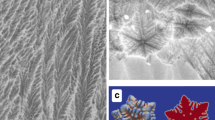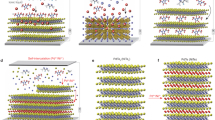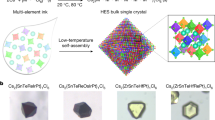Abstract
Liquid crystals consist of anisotropic molecular units, and most are organic molecules. Materials incorporating metals into anisotropic molecules, described as metallomesogens, have been prepared1. Anisotropic structures such as one-dimensional chains and two-dimensional layers are frequently observed in solid-state inorganic materials, however, little is understood about structural organization in melts of such materials. Achieving liquid-crystalline behaviour in inorganic fluids should be possible if the anisotropic structure can be retained or designed into the molten phase. We demonstrated the ability to engineer zeolite-type structures into metal halide glasses and liquids2,3. In this work we have engineered lamellar, cubic and hexagonal liquid-crystalline structure in metal-halide melts by controlling the volume fraction and nature of the inorganic block (up to 80 mol%) with respect to alkylammonium surfactants. The high metal content of these liquid-crystalline systems significantly advances the field of metallomesogens, which seeks to combine magnetic, electronic, optical, redox and catalytic properties common to inorganic materials with the fluid properties of liquid crystals.
This is a preview of subscription content, access via your institution
Access options
Subscribe to this journal
Receive 12 print issues and online access
$259.00 per year
only $21.58 per issue
Buy this article
- Purchase on Springer Link
- Instant access to full article PDF
Prices may be subject to local taxes which are calculated during checkout




Similar content being viewed by others
References
Donnio, B., Guillon, D., Seschenaux, R. & Bruce, D. W. Metallomesogens. Comp. Coord. Chem. II 7, 357–627 (2004).
Martin, J. D., Goettler, S. J., Fosse, N. & Iton, L. Designing intermediate range order in amorphous materials. Nature 419, 381–384 (2002).
Martin, J. D. & Thornton, T. A. Liquid crystalline zinc chloride. in Liquid Crystal Materials and Devices (ed. Bunning, T. J.) Proc. Mater. Res. Soc. 559, 243–248 (1999).
Zocher, H. Occurrence of liquid crystallinity in a borazine polymer. Z. Anorg. Allg. Chem. 147, 91–111 (1925).
Sonin, A. S. Inorganic lyotropic liquid crystals. J. Mater. Chem. 8, 2557–2574 (1998).
Gabriel, J.-C. P. & Davidson, P. New trends in colloidal liquid crystals based on mineral moieties. Adv. Mater. 12, 9–20 (2000).
Li, L. S., Walda, J., Manna, L. & Alivisaos, A. P. Semiconductor nanorod liquid crystals. Nano Lett. 6, 557–560 (2002).
Kim, D.-P. & Economy, J. Occurrence of liquid crystallinity in a borazine polymer. Chem. Mater. 6, 395–400 (1994).
Jiang, T. & Ozin, G. A. Tin(IV) sulfide-alkylamine composite mesophase: a new class of thermotropic liquid crystals. J. Mater. Chem. 7, 2213–2222 (1997).
Firouzi, A., Atef, F., Oertli, A. G., Stucky, G. D. & Chmelka, B. F. Alkaline lyotropic silicate-surfactant liquid crystals. J. Am. Chem. Soc. 119, 3596–3610 (1997).
Skoulios, A. & Luzzati, V. Structure of anhydrous sodium soaps at high temperatures. Nature 183, 1310–1312 (1959).
Neve, F. Transition metal based ionic mesogens. Adv. Mater. 8, 277–289 (1996).
Bowlas, C. J., Bruce, D. W. & Seddon, K. R. Liquid-crystalline ionic liquids. Chem. Commun. 1625–1626 (1996).
Spegt, P. A. & Skoulios, A. E. Structure des savons de strontium en fonction de la température. Acta Crystallogr. 21, 892–897 (1966).
Baena, M. J., Espinet, P., Lequerica, M. C. & Levelut, A. M. Mesogenic behavior of silver thiolates with layered structure in the solid state: covalent soaps. J. Am. Chem. Soc. 114, 4182–4185 (1992).
Busico, V., Castaldo, D. & Vacatello, M. Thermal behavior and liquid crystalline phases of a series of bis(n-alkylammonium)tetrabromozincates. Mol. Cryst. Liq. Cryst. 78, 221–226 (1981).
Neve, F., Crispini, A., Armentano, S. & Francesangeli, O. Synthesis, structure and thermotropic mesomorphism of layered n-alkylpyridinium tetrahalopalladate(II) salts. Chem. Mater. 10, 1904–1913 (1998).
Kanazawa, A., Ikeda, T. & Nagase, Y. Novel class of ionic metallomesogens without organic ligands: thermotropic liquid-crystalline behavior of tetrachlorometalate salts and distinct polymorphic transition in smectic A phases. Chem. Mater. 12, 3776–3782 (2000).
Lee, C. K., Peng, H. H. & Lin, I. J. B. Liquid crystals of n,n-dialkylimidazolium salts comprising palladium(II) and copper(II) ions. Chem. Mater. 16, 530–536 (2004).
Gordon, C. M., Holbrey, J. D., Kennedy, A. R. & Seddon, K. R. Ionic liquid crystals: hexafluorophosphate salts. J. Mater. Chem. 8, 2627–2636 (1998).
Neve, F., Crispini, A. & Francescangeli, O. Structural studies on layered alkylpyridinium iodopalladate networks. Inorg. Chem. 39, 1187–1194 (2000).
Fosse, N., Caldes, M., Joubert, O., Ganne, M. & Brohan, L. Layered alkyltrimethylammonium chromates: thermal and structural investigations and crystal structure of anhydrous bisoctyltrimethylammonium dichromate. J. Solid State Chem. 139, 310–320 (1998).
Kresge, C. T., Leonowicz, M. E., Roth, W. J., Vartuli, J. C. & Beck, J. S. Ordered mesoporous molecular sieves synthesized by a liquid-crystal template mechanism. Nature 359, 710–712 (1992).
Palmqvist, A. E. C. Synthesis of ordered mesoporous materials using surfactant liquid crystals or micellar solutions. Curr. Opin. Colloid Interface Sci. 8, 145–155 (2003).
Tschierske, C. Non-conventional liquid crystals—the importance of micro-segregation for self-organization. J. Mater. Chem. 8, 1485–1509 (1998).
Bruce, D. W. Calamitics, cubics, and columnars—liquid-crystalline complexes of silver(I). Acc. Chem. Res. 33, 831–840 (2000).
Desa, J. A. E., Wright, A. C., Wong, J. & Sinclair, R. N. A neutron diffraction investigation of the structure of vitreous zinc chloride. J. Non-Cryst. Solids 51, 57–86 (1982).
Beggin, S. & Enderby, J. E. The structure of molten zinc chloride. J. Phys. C 14, 3129–3136 (1981).
Barón, M. Definitions of basic terms relating to low-molar-mass and polymer liquid crystals (IUPAC Recommendations 2001). Pure Appl. Chem. 73, 845–895 (2001).
Demus, D. & Richter, L. Textures of Liquid Crystals (Verlag Chemie, Weinheim, GDR, 1978).
Acknowledgements
This work was supported by the NSF (DMR-9501370, DMR-0072828 and DMR-0305086), and general user time on beam line X7b at BNL NSLS supported by contract DE-AC02-98CH10086 with the US DOE Office of Basic Energy Sciences division of chemical sciences. J.D.M. is a Cottrell Scholar of the Research Corporation. The assistance of X7B beamline scientist J. Hanson is gratefully acknowledged. P. Boyle, S. Parkin and C. Day contributed to single-crystal X-ray data collection. NSF-REU students J. L. Brown and J. M. Duerk, ACS Project SEED student S. Townes and J.D.M.’s daughter E. L. Martin all contributed to this work. This work is in part the subject matter of US Patents 6,540,939 and 6,790,382 B2 ‘Templated Compositions of Inorganic Liquids and Glasses’.
Author information
Authors and Affiliations
Corresponding author
Ethics declarations
Competing interests
The subject matter is related to US patents, as stated in the Acknowledgements.
Supplementary information
Supplementary information
Discussion on nomenclature (PDF 43 kb)
Supplementary information
Indexing of the diffraction of the bicontinuous cubic phases (PDF 36 kb)
Supplementary information
C8TAZnCl33 (PDF 80 kb)
Supplementary information
C12TAZnCl50 (PDF 54 kb)
Supplementary information
C12ZnCl_XRDDSC (PDF 114 kb)
Supplementary information
C16CdCl_XRDDSC (PDF 129 kb)
Supplementary information
C16CuCl_XRDDSC (PDF 147 kb)
Supplementary information
C16TACaCuCl50 (PDF 69 kb)
Supplementary information
C16TACdCl50 (PDF 70 kb)
Supplementary information
C16TACuCl25 (PDF 83 kb)
Supplementary information
C16TAZnCl33 (PDF 67 kb)
Supplementary information
C16TAZnCl50 (PDF 51 kb)
Supplementary information
C16ZnCl_XRDDSC (PDF 152 kb)
Rights and permissions
About this article
Cite this article
Martin, J., Keary, C., Thornton, T. et al. Metallotropic liquid crystals formed by surfactant templating of molten metal halides. Nature Mater 5, 271–275 (2006). https://doi.org/10.1038/nmat1610
Received:
Accepted:
Published:
Issue Date:
DOI: https://doi.org/10.1038/nmat1610
This article is cited by
-
Preparation and liquid crystal phase properties of discotic cellulose nanoparticles
Cellulose (2019)
-
Dynamically arrested micelles in a supercooled sugar urea melt
Communications Chemistry (2018)
-
An electrochemical sensing platform based on a new Cd(II)-containing ionic liquid for the determination of trichloroacetic acid and bromate
Ionics (2010)
-
A new Cd(II)-containing ionic liquid: Synthesis, characterization and electrocatalysis
Journal of Chemical Sciences (2010)



